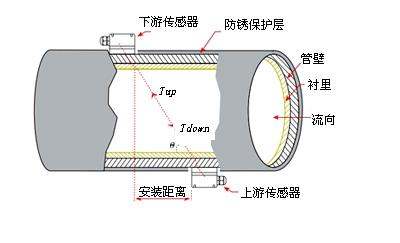
A manufacturing enterprise for all kinds of electroacoustic components
World-wide counseling service hotline
+86 519 81290886According to the principle of signal detection, ultrasonic flowmeter can be divided into propagation velocity difference method (direct time difference method, time difference method, phase difference method and frequency difference method), beam migration method, Doppler method, cross correlation method, spatial filter method and noise method.
1. Time difference method is used to measure the time difference caused by different propagation velocities in positive and negative propagation to calculate the velocity of measured flow body.
It uses two sonic transmitters (SA and SB) and two sonic receivers (RA and RB). Two sets of sound waves from the same source are transmitted between SA and RA and between SB and RB respectively. They are installed along the pipe at an Angle θ with the pipe (generally θ=45°) (Figure 1). Since sound waves traveling downstream are accelerated by the fluid and those traveling upstream are delayed, the time difference between them is proportional to the flow rate. The velocity can also be measured by sending a sinusoidal signal to measure the phase shift between two sets of sound waves or by sending a frequency signal to measure the frequency difference.
2. The phase difference method is used to measure the calculation speed of the phase difference caused by the time difference between normal and negative propagation.
Its transmitter sends a beam of sound waves along an axis perpendicular to the pipe, which is offset some distance downstream by fluid flow. The offset distance is proportional to the flow rate.
3. Frequency difference method is used to measure the frequency difference of the sound ring in the case of positive and negative transmission.
When ultrasonic waves travel through an inhomogeneous fluid, the sound waves scatter. When there is relative motion between the fluid and the transmitter, there will be a Doppler shift between the acoustic signal sent and the signal received after being scattered by the fluid. The Doppler shift is proportional to the velocity of the fluid. The region of the measured flow body in Fig. 2 is located at the intersection of the transmitted beam and the received scattered beam. The beam is required to be very narrow so that the Angle θ between the two beams is not affected by the beam width. It is also possible to use only one converter as both a transmitter and a receiver, which is called single-channel. In a single-channel Doppler blood flowmeter, the transmitter sends sound pulses at intervals and receives the sound pulses reflected from the blood vessel wall and the red blood cells within the vessel during the interval between the two. The control circuit is used to select the red blood cell reflected signals at a given distance, and the Doppler frequency shift, which is proportional to the blood flow velocity, is obtained after comparison. The blood flow can be obtained when the cross section of the vessel is known.


Independent brand (ISENSOR) products include: ultrasonic sensors, buzzers, speakers, etc., with more than 300 specifications and models
Contact us
